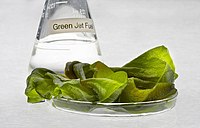
Photo from wikipedia
Waste biomass and dye wastewater pollutions have been the serious environmental problems. The interfacial solar-steam generation technology is an effective and sustainable method for the water purification. However, the complex… Click to show full abstract
Waste biomass and dye wastewater pollutions have been the serious environmental problems. The interfacial solar-steam generation technology is an effective and sustainable method for the water purification. However, the complex preparation process, high economic cost and probably secondary environmental pollution of traditional photo-thermal materials restricted their practical large-scale application. Herein, the biochar cakes (BCs) deriving from waste biomass were prepared, and the granular and schistose MgO coatings were dressed on the surface of carbonized fiber to improve their hydrophilicity. The BCs with high solar absorbance and super-hydrophilicity were applied in the photo-thermal purification of dye wastewater with solar energy. The highest evaporation rate of dye wastewater with BCs reached 2.27 kg m-2 h-1, and the corresponding conversion efficiency of solar to steam generation was 78.98% under the simulated solar irradiation (1846.0 w/m2). The collected clean water from the solar-steam evaporators reached the emission standards of EU Water Framework Directive (91/271/EEC). Considering the simple and economical preparation method, this process made the practical large-scale application of photo-thermal BCs on dye wastewater treatment a reality, and also provided an cost-effective management strategy for the waste biomass.
Journal Title: Environmental research
Year Published: 2021
Link to full text (if available)
Share on Social Media: Sign Up to like & get
recommendations!